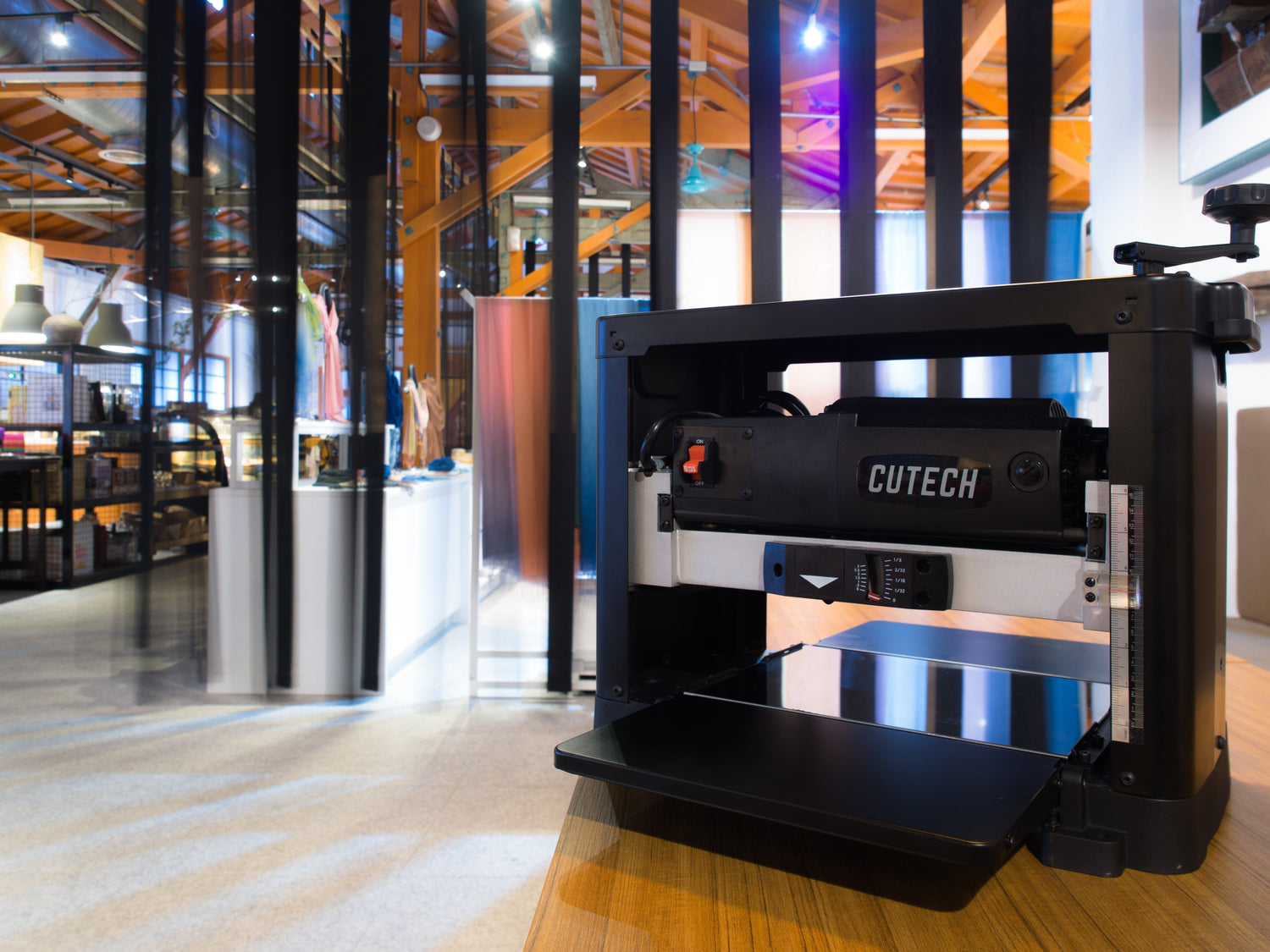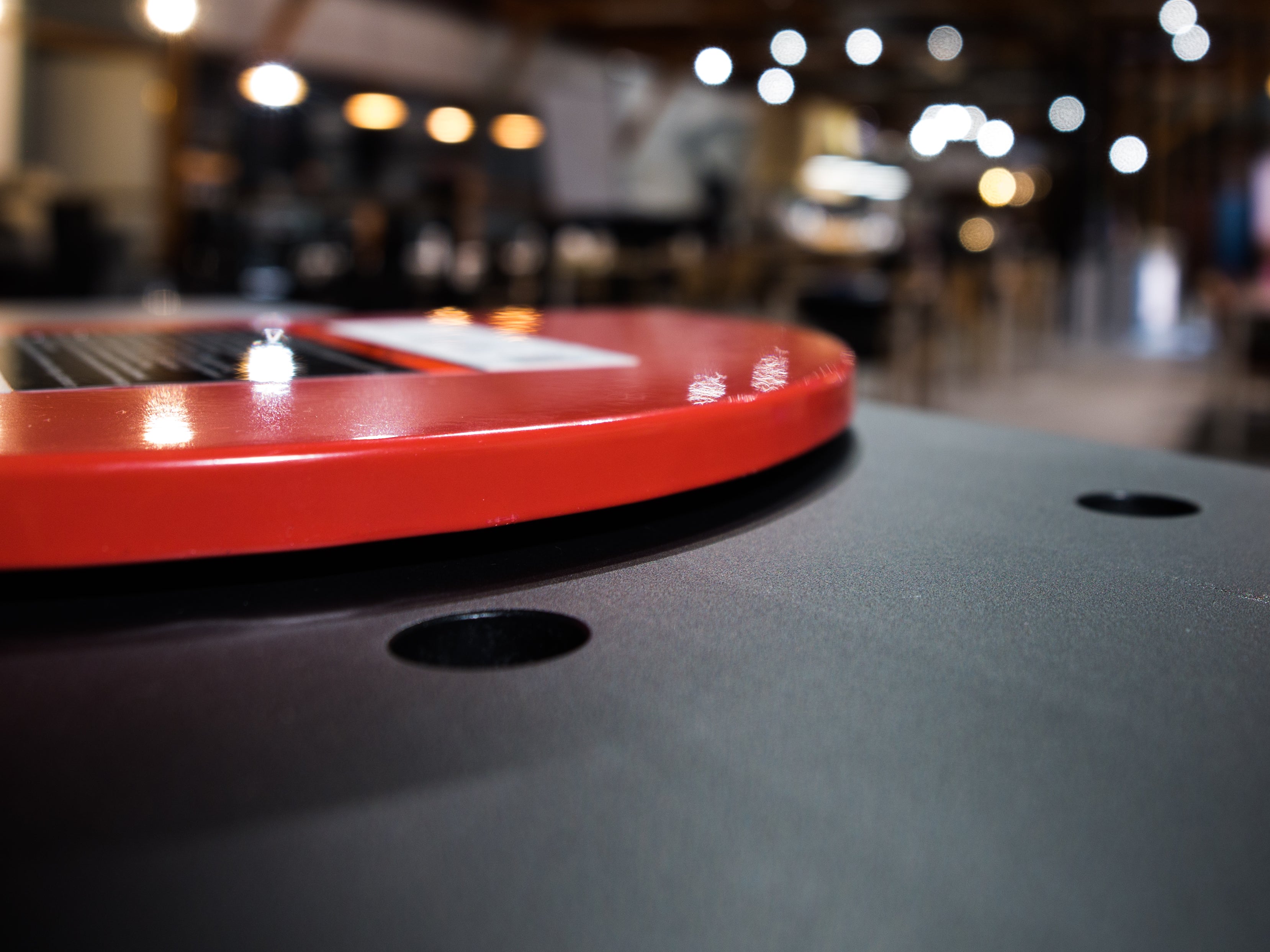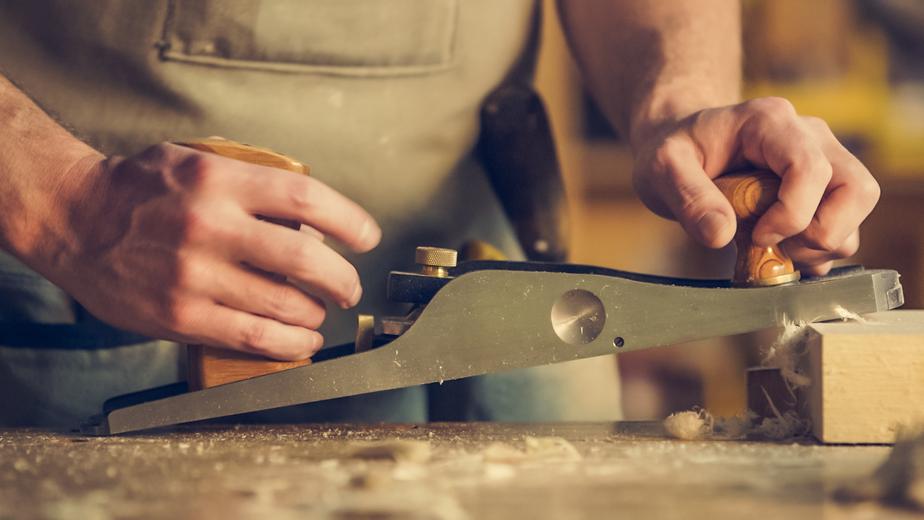Last Updated March 9, 2025
Discover the essential role of a wood planer in woodworking. This guide explains what does a wood planer do and provides tips on selecting the best planer for your woodworking project.
Table of Contents
Looking to upgrade your woodworking equipment? Adding a thickness planer is one of the smartest decisions you can make.
Whether you are a professional woodworker or a weekend warrior, a thickness planer is one of the most valuable tools to have at your disposal.
If you are exploring what a planer is used for and unsure if the purchase of one is right for you, the following guide will point you in the right direction.
What is a Wood Planer?

A wood planer is a woodworking tool used to create smooth, even surfaces on a board and to ensure that both faces are parallel. Also known as a thickness planer, it plays a critical role in reducing a board’s thickness while maintaining its flatness, making it an essential tool for dimensioning lumber.
A wood planer is made up of several key components that work together to smooth and dimension lumber. Here are the three key components of a wood planer:
Key Components:
-
In-feed and Out-feed Rollers: The rollers on a wood planer play a crucial role in feeding, stabilizing, and guiding the wood through the machine. They work together to ensure a consistent feed rate and precise cutting.
-
Cutterhead: Located below the upper frame, the cutterhead contains sharp blades or cutters that shave off a thin layer of wood to create a smooth, flat surface.
-
Depth Adjustment Mechanism: This allows users to control how much wood is removed, ensuring the desired thickness and precision.
What is a Wood Planer Used For?
A wood planer is primarily used to ensure boards have a consistent thickness and smooth surfaces. Here’s what it’s commonly used for:
Thicknessing Lumber
The main function of a wood planer is to reduce the thickness of a board to a desired dimension while maintaining a flat surface. This is particularly useful when working with rough or irregular boards, as the planer ensures both faces are perfectly parallel and uniform.
Smoothing Surfaces
A wood planer removes rough saw marks and uneven surfaces from lumber, leaving behind a smooth finish. This is essential when preparing boards for joinery, finishing, or assembly, ensuring a professional look and feel.
Creating Parallel Faces
After one face of a board has been flattened using a jointer, the planer ensures the opposite face is parallel to the first. This is crucial for creating dimensioned lumber with consistent thickness and flat surfaces on both sides.
What’s the Difference Between Wood Jointer and Planer?
If you’re diving into woodworking, you’ve probably come across two essential machines: the jointer and the planer. While both are used for preparing wood, they serve different functions in creating smooth, flat surfaces.
-
Wood jointer: A jointer is specifically designed to flatten one face of a board and square up one edge. When dealing with rough or warped lumber, the jointer ensures a flat surface on one side and a perfectly squared edge, making the wood ready for further work.
-
Wood Planer: A planer (or thickness planer) is used to make both faces of the board parallel and achieve a consistent thickness. After one face is flattened with the jointer, the planer smooths and levels the opposite face, ensuring both sides are even and parallel.
In short, the jointer flattens and squares, while the planer ensures uniform thickness. Together, they help transform rough wood into precise, workable material.
For more details, check out our extended guide: Jointer vs. Planer
Types of Planers
Manual Hand Planer Introduction
The most basic planer is the manual hand planer. This cost effective tool is available in an assortment of sizes. The smallest hand planers are used to shave off door edges that are sticking or swollen. The larger hand planers have adjustments for the amount of material to be removed. These are used to smooth out longer boards that may be rough cut or have defects.
Electric Hand Planer Introduction
Physical effort is required in using a hand planer to shave off thin layers of material. The introduction of the electric hand planer made woodworking faster and easier. Physical dexterity becomes less important as this small power tool takes over the tedious hard labor of smoothing out a board. This simple machine has an adjustable front shoe to determine the depth of cut. The blades are attached to a rotating cutter head that does the hard work of removing material. Even pressure is necessary to prevent snipe on the ends of the boards.
Benchtop Planer Introduction
Next, we will take a closer look at the benchtop planer, a machine expressly designed to not only smooth the surface of the wood but to also trim boards to a uniform thickness. Whether you are making musical instruments or gluing stacks of boards together for a cutting board, a smooth board with consistent thickness is the first step to just about any project. The structural features of a benchtop planer mainly consists of a table, feed rollers, cutterhead and knives / inserts. The board is laid on the table and fed into the machine by the rollers. The cutterhead is mounted on a frame that can be lowered to trim off the board surface. For a consistent thickness, one side of the board must be flattened first. This flattened side will face the table as the opposing side is smoothed and thicknessed by the knives on the cutterhead.
The evolution of the knives is worth a mention as performance has increased over the years. Initially the cutterhead was outfitted with 2 or 3 straight blades made of SK5, a low to mid range carbon steel material. The nondurable SK5 led to the use of high speed steel (HSS). In addition to the straight blades, a different kind of cutters known as inserts are used by staggering them on the cutterhead. This design leads to reduced noise as well as being more cost effective by simply replacing damaged inserts instead of an entire straight blade. To further improve on the durability of inserts, the next upgrade we see is the introduction of tungsten carbide inserts. This material gives the consumer a longer lasting sharp edge on the cutters.
The launch of benchtop planers meant that DIYers finally had access to what large furniture makers were using to craft their work without the expense and space requirements. The array of benchtop planers available today is meant for every budget, from the small and simple machines to large machines with speciality features.
What to Consider When Choosing Benchtop Planers
The selection of benchtop planers on the market is wide and may seem daunting if you are purchasing your first planer. A review of the available options may help clarify the decision making process.
If selecting a benchtop wood planer, it is imperative that you understand how to unlock the full potential of this thickness planer type. The best wood planers should be matched to your budget, but it is equally crucial that it has the attributes for your intended job. The most important elements are detailed below:
● Cutterhead Type
An important component is the cutterhead. There are 3 options: straight, helical and spiral designs.
- straight cutterhead: The traditional setup is the straight blade cutterhead. The 2-3 knives run the length of the cutterhead and the knives take long thin slices of wood off the board. This low cost option operates at a higher noise level and the straight blades are more likely to cause tear-out.
- helical cutterhead: The helical cutterhead utilizes inserts that cut at one point thus creating a high resistance to the motor. It does produce a nice finish and operates at a much lower noise level than machines with straight knives. The downside of the helical cutterhead is the price. The helical cutterhead machine is usually priced much higher than any other benchtop planer.
- spiral cutterhead: The balance between the straight blade and the helical design is the spiral cutterhead. The conception of the spiral cutterhead is borne out of a desire for a fine finish like the helical design but at a much more budget friendly price. The spiral cutterhead uses inserts that cut in short segments. It runs quietly and the lower motor burden means that the motor is less likely to burn out. Aside from the design of the cutterhead, machines come in different sizes.
● Capacity
The smaller machines can plane boards as wide as 12 1/2” (12”) and 6" thick while the larger machines can take boards as wide as 13" and 6" thick.
● Blade / Knife Material
The knives and inserts that are available for the cutterheads vary in material and price points. The straight knives often use SK5 or high speed steel blades. Since a single nick would require the entire blade to be replaced, it is a more costly option in a way. The helical and spiral models use small cutters that can easily be changed out as needed therefore the cost of replacement is limited to the single, damaged insert. The options for inserts are high speed steel or tungsten carbide.
The helical cutters are arranged in rows that spiral around the cutterhead while the spiral cutters are staggered in straight rows. Both these designs require the inserts to conform to strict standards as deviations in insert sizes will cause lines in the finish.
● Two-Speed
A limited number of benchtop planers will have the handy 2- speed feed rate. For consumers working with hardwoods or figured wood, slowing down the feed rate will enhance the finish and reduce the occurrence of tearout.
● Snipe Reduce Mechanism
Benchtop planers will cut more deeply on the ends of the wood, known as snipe. In the absence of a snipe reducing mechanism, the snipe may be as deep as 0.25mm. The addition of a manual snipe lock element to stabilize the upper frame can reduce snipe. The other auto minimizer design on some models will minimize snipe automatically. This method further (Both methods) reduces snipe to a mere 0.13-0.15 mm, unnoticeable to the eye.
Learn more: 4 essential ways to minimize snipe
● Handy Features
Other components to consider such as repeat cut depth stops, depth of cut indicator and return rollers will add to the price tag of the machine but may bring efficiency to the job that is needed.
How to Use a Planer
Learning to use a benchtop planer correctly will save time and money from costly mistakes. Make sure that the boards are free from foreign materials such as staples and nails which can cause damage to your machine.
Once one side of the board is flattened, place the flat side down on the planer and lower the upper frame so that it touches the board. Every quarter turn of the handle lowers the upper frame about 1/16”.
Push the board forward and the depth of cut indicator will show how much material will be removed. Push further till the infeed roller is able to feed the board toward the cutterhead. Once the desired amount is cut, the board is fed by the outfeed roller to exit the machine. The scale on the side assists with how thick the wood will be after planing.
Related article: How to Use a Planer: Master the Basics in 4 Easy Steps
Best Benchtop Planers Worth Considering for 2024
Explore the top-rated planers for 2023. One will be a perfect match for your level of expertise and budget. We have selected to review five highly ranked benchtop planers for professionals and DIYers alike.
DEWALT DW735 13-INCH PLANER

The ever popular DW735 is a classic example of the 3 straight blade machine with a dual speed feed rate. It comes standard with a fan assisted chip removal to keep the machine running free from chip debris. The upper frame lowers with 4-lead screws, giving extra stability for snipe control. A reputable brand with a quality machine that has been around for years.
|
Feature |
a classic example of the 3 straight blade machine with a dual speed feed rate |
|
Type |
Stationary planer |
|
Motor |
15 amps |
|
Cutting Width |
13 inches |
|
Cutterhead |
Three straight |
WEN PL1326 13-INCH PLANER

The PL1326 is considered top of the line for the spiral cutterhead models. Its 15 AMP motor generates 10,000 RPM with a 26 feet per minute feed rate. The spiral cutterhead holds 26 staggered, 2-sided inserts for a superior finish and quiet operation. The 4- lead screw design lends itself to minimal snipe and large extension tables support longer pieces of work. For the weekend warrior, this favorite design is high in quality and dependability.
|
Feature |
top of the line for the spiral cutterhead models |
|
Type |
Benchtop planer |
|
Motor |
15 amps |
|
Cutting Width |
13 inches |
|
Cutterhead |
Helical |
CUTECH 40800H 13-INCH PLANER

The 40800H is Cutech's newest addition to its 13" benchtop planer family. It boasts every feature a planer can have to make planing a quick and easy job. The 2-speed feed rate allows users to expand their woodworking to include the more difficult woods like oak and teak. The patented coupling design (Snipe Minimizer) with 4-lead screws automatically minimizes snipe to less than 13mm.
|
Feature |
2-speed feed rate planer which makes planing a quick and easy job |
|
Type |
Benchtop planer |
|
Motor |
15 amps |
|
Cutting Width |
13 inches |
|
Cutterhead |
Spiral |
CRAFTSMAN CMEW320 12 ½-INCH PLANER

The CMEW320 is a solid 2 blade machine, perfect for home projects. The dust port makes chip removal a breeze. The 12-1/2” compact design makes this model more affordable.
|
Feature |
a solid 2 blade machine, perfect for home projects |
|
Type |
Benchtop planer |
|
Motor |
15 amps |
|
Cutting Width |
12½ inches |
|
Cutterhead |
Two straight |
CUTECH 40200H 13-INCH PLANER
The 40200H is a classic design with a side crank that many users find more comfortable to use. The much reviewed snipe lock can be engaged to minimize snipe to less than 0.15mm. The extra large extension tables can be folded up for compact storage. The 8-position repeat cut depth stop has preset the most used board thicknesses to make planing simple and fast.
|
Feature |
a classic design with a side crank that users easy to use |
|
Type |
Benchtop planer |
|
Motor |
15 amps |
|
Cutting Width |
13 inches |
|
Cutterhead |
Spiral |
Learn more about CUTECH 40200H planer
Quality Woodworking Planer - Cutech
CUTECH 40800H 13-INCH PLANER
The 40800H is Cutech's newest addition to its 13" benchtop planer family. It boasts every feature a planer can have to make planing a quick and easy job. The 2-speed feed rate allows users to expand their woodworking to include the more difficult woods like oak and teak. The patented coupling design with 4-lead screws automatically minimizes snipe without having to engage and disengage an additional snipe lock. The return rollers on top assists board return quickly for the next planing. Thicknessing a board is a snap with the 8-position repeat cut depth stop. From 1/4" to 1 3/4", the preset depth stops ensure one doesn't accidently take too much off.
Learn more about CUTECH 40800H planer
CUTECH 40600H 13-INCH PLANER
The 2023 new design with a side crank that many users find more comfortable to use. The use the 4 Lead Screws for elevation with the patented Coupling Units design (Snipe Minimizer) effectively reducing snipe to less than 0.13mm. These new designs make the 40600H cost effective and have additional features such as the Board Return Rollers but are priced budget friendly.
Learn more about CUTECH 40600H planer
CUTECH 40700H 12 ½-INCH PLANER
The 40700H is Cutech's smallest benchtop planer offering. This machine is terrific for smaller work pieces and the perfect size to take on the job. The spiral cutterhead holds 24 2-sided inserts to thickness boards as wide as 12 1/2". When larger isn't always necessary, this compact machine gets the job done and is reasonably priced for those on a budget.
Learn more about CUTECH 40700H planer




